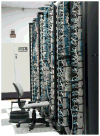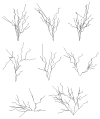Towards a large-scale biologically realistic model of the hippocampus
- PMID: 23366951
- PMCID: PMC4172354
- DOI: 10.1109/EMBC.2012.6346990
Towards a large-scale biologically realistic model of the hippocampus
Abstract
Real neurobiological systems in the mammalian brain have a complicated and detailed structure, being composed of 1) large numbers of neurons with intricate, branching morphologies--complex morphology brings with it complex passive membrane properties; 2) active membrane properties--nonlinear sodium, potassium, calcium, etc. conductances; 3) non-uniform distributions throughout the dendritic and somal membrane surface of these non-linear conductances; 4) non-uniform and topographic connectivity between pre- and post-synaptic neurons; and 5) activity-dependent changes in synaptic function. One of the essential, and as yet unanswered questions in neuroscience is the role of these fundamental structural and functional features in determining "neural processing" properties of a given brain system. To help answer that question, we're creating a large-scale biologically realistic model of the intrinsic pathway of the hippocampus, which consists of the projection from layer II entorhinal cortex (EC) to dentate gyrus (DG), EC to CA3, DG to CA3, and CA3 to CA1. We describe the computational hardware and software tools the model runs on, and demonstrate its viability as a modeling platform with an EC-to-DG model.
Figures



Similar articles
-
The contribution of relative activation levels between populations of cells to network activity in a large-scale biologically realistic model of the hippocampus.Annu Int Conf IEEE Eng Med Biol Soc. 2013;2013:5962-5. doi: 10.1109/EMBC.2013.6610910. Annu Int Conf IEEE Eng Med Biol Soc. 2013. PMID: 24111097 Free PMC article.
-
Nonlinear dynamic modeling of spike train transformations for hippocampal-cortical prostheses.IEEE Trans Biomed Eng. 2007 Jun;54(6 Pt 1):1053-66. doi: 10.1109/TBME.2007.891948. IEEE Trans Biomed Eng. 2007. PMID: 17554824
-
Input-output relations in the entorhinal cortex-dentate-hippocampal system: evidence for a non-linear transfer of signals.Neuroscience. 2006 Sep 29;142(1):247-65. doi: 10.1016/j.neuroscience.2006.06.001. Epub 2006 Jul 14. Neuroscience. 2006. PMID: 16844310
-
Hippocampal place cells: parallel input streams, subregional processing, and implications for episodic memory.Hippocampus. 2006;16(9):755-64. doi: 10.1002/hipo.20203. Hippocampus. 2006. PMID: 16883558 Review.
-
Hippocampus, microcircuits and associative memory.Neural Netw. 2009 Oct;22(8):1120-8. doi: 10.1016/j.neunet.2009.07.009. Epub 2009 Jul 18. Neural Netw. 2009. PMID: 19647982 Review.
Cited by
-
Volterra representation enables modeling of complex synaptic nonlinear dynamics in large-scale simulations.Front Comput Neurosci. 2015 Sep 17;9:112. doi: 10.3389/fncom.2015.00112. eCollection 2015. Front Comput Neurosci. 2015. PMID: 26441622 Free PMC article.
-
Multi-scale spiking network model of human cerebral cortex.Cereb Cortex. 2024 Oct 3;34(10):bhae409. doi: 10.1093/cercor/bhae409. Cereb Cortex. 2024. PMID: 39428578 Free PMC article.
-
Implementation of topographically constrained connectivity for a large-scale biologically realistic model of the hippocampus.Annu Int Conf IEEE Eng Med Biol Soc. 2012;2012:1358-61. doi: 10.1109/EMBC.2012.6346190. Annu Int Conf IEEE Eng Med Biol Soc. 2012. PMID: 23366151 Free PMC article.
-
A million-plus neuron model of the hippocampal dentate gyrus: Dependency of spatio-temporal network dynamics on topography.Annu Int Conf IEEE Eng Med Biol Soc. 2015;2015:4713-6. doi: 10.1109/EMBC.2015.7319446. Annu Int Conf IEEE Eng Med Biol Soc. 2015. PMID: 26737346 Free PMC article.
-
Implementation of activity-dependent synaptic plasticity rules for a large-scale biologically realistic model of the hippocampus.Annu Int Conf IEEE Eng Med Biol Soc. 2012;2012:1366-9. doi: 10.1109/EMBC.2012.6346192. Annu Int Conf IEEE Eng Med Biol Soc. 2012. PMID: 23366153 Free PMC article.
References
-
- Hines ML, Carnevale NT. The NEURON simulation environment. Neural Computation. 1997;9:1179–1209. - PubMed
-
- Oliphant Travis E. Python for Scientific Computing. Computing in Science and Engineering. 2007 May-Jun;9(3):10–20.
-
- Hillman DE. The Neurosciences, 4th Study Program. MIT Press; Cambridge: 1979. Neuronal Shape Parameters and Substructures as a Basis of Neuronal Form; pp. 477–498.
-
- Ascoli G, Krichmar JL. L-Neuron: A Modeling Tool for the Efficient Generation and Parsimonious Description of Dendritic Morphology. Preprint of Article to appear in Neurocomputing. 2000
Publication types
MeSH terms
Grants and funding
LinkOut - more resources
Full Text Sources
Miscellaneous
